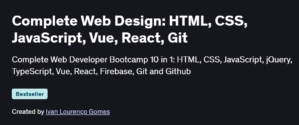What will you learn in Web Developer Certification Training Course
Build full-stack web applications using HTML5, CSS3, JavaScript, and popular frameworks
Develop server-side APIs with Node.js, Express.js, and integrate databases (MongoDB/MySQL)
Implement responsive, mobile-first designs with Bootstrap and CSS Flex/Grid layouts
Enhance UX with dynamic front-end frameworks: React or Angular (choose your track)
Secure and optimize web apps: authentication (JWT/OAuth), input validation, caching, and performance tuning
Deploy applications using Docker, CI/CD pipelines, and cloud platforms (AWS/Azure/GCP)
Program Overview
Module 1: Front-End Foundations
⏳ 2 weeks
Topics: Semantic HTML, CSS3 selectors, box model, Flexbox/Grid
Hands-on: Build responsive multi-section landing pages and navigation bars
Module 2: JavaScript & DOM Manipulation
⏳ 2 weeks
Topics: ES6+ syntax, event handling, DOM traversal, AJAX/fetch API
Hands-on: Create interactive UI components (modals, tabs) and fetch external data
Module 3: Front-End Framework (React/Angular)
⏳ 3 weeks
Topics: Component architecture, state management (Redux or RxJS), routing, hooks/services
Hands-on: Develop a SPA with dynamic routing, form handling, and global state
Module 4: Back-End Development with Node.js
⏳ 2 weeks
Topics: Express.js fundamentals, middleware, RESTful API design, error handling
Hands-on: Build CRUD APIs for user and product resources with JWT-based auth
Module 5: Databases & ORMs
⏳ 1 week
Topics: MongoDB (Mongoose) or MySQL (Sequelize) schemas, relationships, migrations
Hands-on: Model application data, implement complex queries, and seed demo datasets
Module 6: Authentication & Security
⏳ 1 week
Topics: JWT, OAuth2 social logins, password hashing, Helmet, rate limiting, CORS
Hands-on: Secure endpoints, implement role-based access, and protect against common OWASP risks
Module 7: DevOps & Deployment
⏳ 1 week
Topics: Dockerfile & Docker Compose, CI/CD with GitHub Actions/Jenkins, cloud deployment
Hands-on: Containerize full-stack app, automate builds/tests, deploy to AWS EC2 or Azure App Service
Module 8: Performance & Testing
⏳ 1 week
Topics: Front-end bundling (Webpack), caching strategies, API load testing, unit/integration tests (Jest/Mocha)
Hands-on: Benchmark endpoints, write test suites for both client and server, optimize build sizes
Module 9: Capstone Project – Production-Ready Web App
⏳ 2 weeks
Topics: End-to-end architecture, CI/CD best practices, monitoring/logging (Prometheus/ELK)
Hands-on: Deliver a fully featured web application with user authentication, data visualization, and live updates
Get certificate
Job Outlook
Full-stack developers are in high demand across startups and enterprises, with roles like Web Developer, MERN/MEAN Engineer, and DevOps-Enabled Developer
Salaries range from $75,000 to $140,000+ depending on stack depth and location
Mastery of front- and back-end skills, combined with deployment and testing expertise, accelerates career growth into senior and architect positions
Explore More Learning Paths
Take your web development skills to the next level with these hand-picked programs designed to strengthen your foundation, expand your capabilities, and accelerate your path to becoming a full-stack developer.
Related Courses
Web Development for Beginners Specialization Course – Build a solid understanding of core web technologies and start creating responsive, modern websites from scratch.
HTML, CSS, and JavaScript for Web Developers Course – Master the essential front-end skills needed to design and develop interactive, user-friendly web pages.
HTML, CSS, and JavaScript for Web Developers Specialization Course – Deepen your expertise across foundational web technologies and build real-world projects to strengthen your developer portfolio.
Related Reading
Gain deeper insight into how project management drives real-world success:
What Is Project Management? – Understand the principles that make every great project a success story.
Specification: Web Developer Certification Training Course
|
FAQs
- No prior experience is required; the course is designed for beginners.
- It introduces HTML, CSS, and JavaScript step by step.
- Learners gradually build skills by creating simple web pages and interactive features.
- Basic computer literacy helps, but programming concepts are explained clearly.
- By the end, learners can create functional, responsive websites independently.
- Yes, the course covers both frontend (HTML, CSS, JavaScript) and backend development concepts.
- Learners are introduced to server-side programming, databases, and APIs.
- Projects demonstrate how frontend and backend integrate to form full-stack applications.
- Practical exercises help build real-world web development skills.
- Advanced backend frameworks may require additional study beyond the course.
- Yes, responsive design techniques are taught using CSS and modern layouts.
- Learners practice using media queries, flexible grids, and adaptive elements.
- Skills ensure websites work effectively on desktops, tablets, and mobile devices.
- Projects include real-world examples to reinforce responsive design principles.
- Advanced responsive features may require further experimentation.
- Yes, the course introduces connecting web applications to databases and APIs.
- Learners practice retrieving, displaying, and managing dynamic data.
- Integration techniques demonstrate real-world application functionality.
- Basic security and error-handling concepts are discussed.
- More complex database structures or advanced API integrations may require additional learning.
- Yes, the course includes hands-on projects to showcase your skills.
- Learners create complete websites and web applications suitable for a portfolio.
- Guidance on deploying projects online for potential employers or clients is included.
- Projects reinforce concepts like responsive design, interactivity, and backend integration.
- Continued practice and personal projects will further enhance your portfolio.





